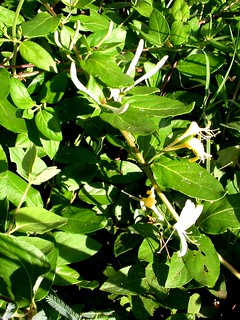Join the Friends of Mount Majura working bee to remove woody weeds in the reserve behind Rivett Street and the drainage line close to the Hackett reservoir.
Come at 9am for a little ramble to learn about the most common woody weeds.

Over 70% of the 136 young woody weeds found within four square meters in the reserve behind Rivett Street, are Privet (Photograph Waltraud Pix, 01.02. 2013).
When: Sunday, 19 May 2013; from 9.00am to 12.00noon.
Where: Meet at ParkCare notice board opposite of the water reservoir off Rivett Street and French Street intersection, Hackett – click on this map.
Bring: Sun protection, body covering garden clothing and sturdy shoes.
Enquiries: admin@majura.org or ph. 6247 7515.
Download this poster for event promotion.
This will be a Search & Destroy activity. We will be cutting and daubing woody weeds using the herbicide glyphosate (Round-up); young weeds that grow in the soft soil at the bottom of the drainage line may be pulled out. Two weed species frequently found in the area are featured below.

The Broad-leaved Privet, Ligustrum lucidum from China is a common woody weed that invades the moister sites and gullies of Mount Majura.
Birds, especially the Pied Currawong, Strepera graculina, eat the berry fruits and excrete the seeds into native bushland.
The cultivation of Privet in suburban gardens along with other exotic winter berry plants like Firethorn and Cotoneaster has tipped the balance of bird life in favour of Currawongs.
In addition to eating fruits, the omnivorous Currawong preys on eggs and nestlings of other birds to feed their own offspring. They have been recorded taking nestlings of small birds like Thornbills and Fairy Wrens, but also the nestlings of larger species such as Bronze-winged pigeons.
Unnaturally large Currawong populations have the potential to decimate declining woodland birds.
Japanese Honeysuckle, Lonicera japonica is a vigorous vine and creeper often grown in gardens to cover fences and old tree stumps. The declared pest plant spreads by stems (garden debris) that are dumped in the reserve and by seed (birds eat berries). It is a problem in wetter areas such as gullies and drainage lines where it can cover large areas and smother native vegetation. Control is labour intensive as multiple stems require cut and daub or pulling (only young plants) and removal from site.


Control of woody weeds using the cut and daub method.
Cut stems close to ground level and immediately treat cut surface with herbicide glyphosate (Roundup or equivalent product) applied at high concentration e.g. 1 part glyphosate : 2 parts water; apply herbicide mix with spray.
The plant’s natural protective mechanism acts very quickly to seal off the cut surface which stops herbicide penetration into the sap stream. It is therefore important to treat the cut surface immediately, i.e. within 30 seconds after cut; the longer the treatment is delayed, the poorer the result will be. If necessary cut and treat each stem of a multi-stemmed plant separately to avoid delayed herbicide treatment.


